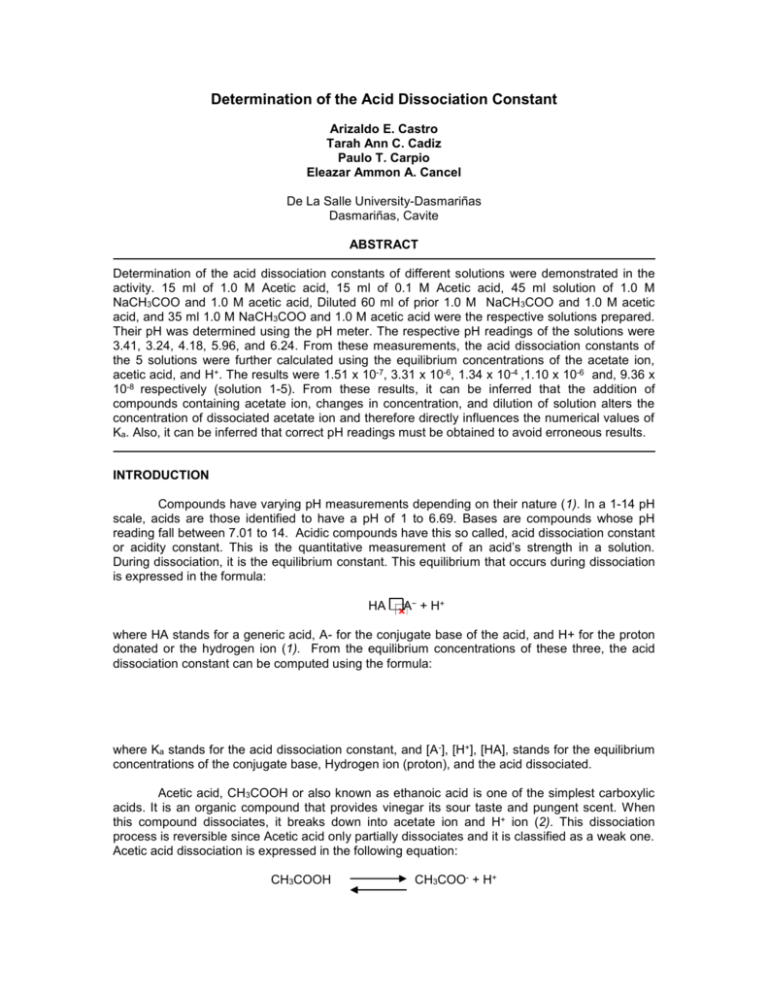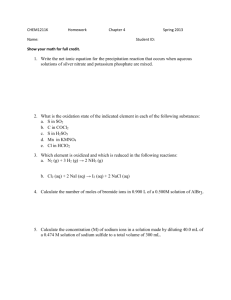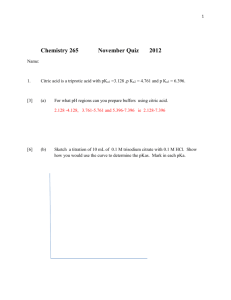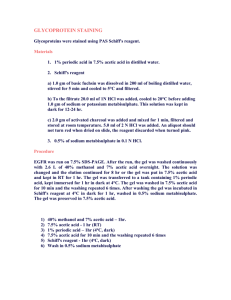Determination of the Acid Dissociation Constant
advertisement

Determination of the Acid Dissociation Constant Arizaldo E. Castro Tarah Ann C. Cadiz Paulo T. Carpio Eleazar Ammon A. Cancel De La Salle University-Dasmariñas Dasmariñas, Cavite ABSTRACT Determination of the acid dissociation constants of different solutions were demonstrated in the activity. 15 ml of 1.0 M Acetic acid, 15 ml of 0.1 M Acetic acid, 45 ml solution of 1.0 M NaCH3COO and 1.0 M acetic acid, Diluted 60 ml of prior 1.0 M NaCH 3COO and 1.0 M acetic acid, and 35 ml 1.0 M NaCH3COO and 1.0 M acetic acid were the respective solutions prepared. Their pH was determined using the pH meter. The respective pH readings of the solutions were 3.41, 3.24, 4.18, 5.96, and 6.24. From these measurements, the acid dissociation constants of the 5 solutions were further calculated using the equilibrium concentrations of the acetate ion, acetic acid, and H+. The results were 1.51 x 10-7, 3.31 x 10-6, 1.34 x 10-4 ,1.10 x 10-6 and, 9.36 x 10-8 respectively (solution 1-5). From these results, it can be inferred that the addition of compounds containing acetate ion, changes in concentration, and dilution of solution alters the concentration of dissociated acetate ion and therefore directly influences the numerical values of Ka. Also, it can be inferred that correct pH readings must be obtained to avoid erroneous results. INTRODUCTION Compounds have varying pH measurements depending on their nature (1). In a 1-14 pH scale, acids are those identified to have a pH of 1 to 6.69. Bases are compounds whose pH reading fall between 7.01 to 14. Acidic compounds have this so called, acid dissociation constant or acidity constant. This is the quantitative measurement of an acid’s strength in a solution. During dissociation, it is the equilibrium constant. This equilibrium that occurs during dissociation is expressed in the formula: HA A− + H+ where HA stands for a generic acid, A- for the conjugate base of the acid, and H+ for the proton donated or the hydrogen ion (1). From the equilibrium concentrations of these three, the acid dissociation constant can be computed using the formula: where Ka stands for the acid dissociation constant, and [A-], [H+], [HA], stands for the equilibrium concentrations of the conjugate base, Hydrogen ion (proton), and the acid dissociated. Acetic acid, CH3COOH or also known as ethanoic acid is one of the simplest carboxylic acids. It is an organic compound that provides vinegar its sour taste and pungent scent. When this compound dissociates, it breaks down into acetate ion and H+ ion (2). This dissociation process is reversible since Acetic acid only partially dissociates and it is classified as a weak one. Acetic acid dissociation is expressed in the following equation: CH3COOH CH3COO- + H+ The acid dissociation constant of a certain acid species in a solution is primarily affected by the addition of a certain compound that will also form the same conjugate base that the acid forms. Dilution also affects the acid dissociation constant as well as the concentration of the acid itself. Before the experiment was started, it was inferred that the concentration of the acid, addition of other compounds, and dilution will certainly affect the acid dissociation constant of the solutions under observation. MATERIALS AND METHODS 5 working solutions were prepared in small beakers. These are: 15 ml solution of 1.0 M acetic acid, 15 ml solution of 0.1 M acetic acid, 30.0 ml of 1.0 M Sodium acetate and 15 ml of 1.0 M acetic acid, 10 ml of 45 ml of 1.0 M Sodium acetate and 1.0 M acetic acid prior solution diluted with 50 ml water, and 5.0 ml 1.0 M Sodium acetate and 30.0 ml 1.0 M acetic acid. The pH measurements of these solutions were determined using the digital pH meter with silver electrode (2). Each solution was tested for its pH using the glass electrode of the digital pH meter. Every time that the electrode was dipped in order to get the pH of the solution, it was first washed with distilled water to avoid contamination and to get the correct reading of the solution’s pH (2). After the 5 solutions’ pH readings were noted down, their respective Ka or acid dissociation constants were computed using the concentration of Acetate ions, H+ ions, and acetic acid. The below formula was used to calculate the Ka of each prepared solution: (2). Ka= [CH3COO-][H+] [CH3COOH] RESULTS AND DISCUSSIONS Table 1. Data Gathered for Acid Dissociation Constants of 5 solutions Solutions pH [H+] [acetate] [acetic acid] Ka 1.0 M acetic acid 0.10 M acetic acid 30 ml 1M Sodium acetate and 15 ml 1 M acetic acid 10 ml of mixture in no. 3 and 50 ml H2O 5.0 ml 1M Sodium acetate and 30 ml of 1 M acetic acid 3.41 3.89 x 10-4 3.89 x 10-4 1 1.51 x 10-7 3.24 5.75 x 10-4 5.75 x 10-4 0.10 3.31 x 10-6 4.18 6.61 x 10-5 0.67 0.33 1.34 x 10-4 5.96 1.10 x 10-6 0.06 0.06 1.10 x 10-6 6.24 5.75 x 10-7 0.14 0.86 9.36 x 10-8 From Table 1, It can be said that mixture no. 3, the 45 ml solution of 1 M Sodium Acetate and 1 M acetic acid has the highest acid dissociation constant with a value of 1.34 x 10 -4. From this data, it can be inferred that this mixture has the highest strength among the others. This can be traced to the additional concentration that Sodium acetate brought. The dissociation reaction is expressed as follows NaCH3COO CH3COOH CH3COO- + Na+ CH3COO- + H+ Figure 1. Dissociation Reaction for Solution no. 3 In the computation for the experimental acid dissociation constant of solution no. 3, the initial concentration of the acetate ion will not be solely dependent on the concentration of Acetic acid. Since when Sodium acetate dissociates, it gives Sodium ions and Acetate ions, it will add to the Acetate ions that Acetic acid will give off, therefore, increasing its concentration. This also signifies that Sodium acetate is a stronger acid than Acetic acid is. This is further explained by the amount of these acids used in both mixtures. In solution no. 3, 30 ml of Sodium acetate was mixed with 15 ml of Acetic acid. In solution no. 5, 5 ml of Sodium acetate was mixed with 30 ml of Acetic acid. Since solution 3 yielded a higher Ka compared to solution 5, therefore, Sodium acetate adds more to the strength of the solution and therefore it is stronger than Acetic acid is. Conversely, adding Sodium acetate to the Acetic acid solution lowers its acidity (pH). It can also be noted from Table 1 that the 1.0 M Acetic acid and 0.1 M Acetic acid have different Ka values. The concentration of an acid also plays a role in its dissociation. Stronger acids tend to dissociate more in a solution while weaker acids tend to dissociate partially, therefore making the process reversible. Acetic acid with higher Molar concentration yielded lower acid dissociation constant while the Acetic acid solution with lower Molar concentration resulted to higher acid dissociation constant. Dilution also plays a role in the alteration of Ka values. Dilution lessens the acid dissociation constant. Since it only lessens the solute’s concentration, it lowers the acid dissociation constant as well. A big difference exists between the experimentally obtained K a and the actual acid dissociation constant of Acetic acid. The actual Ka of Acetic acid is 1.8 x 10-5. When considered against the experimental Ka of 1.0 M Acetic acid, a percentage error of 99% can be computed. On the other hand, the experimental Ka of 0.1 M Acetic acid yielded a percentage error of 82%. This implies that too much contamination has occurred. Contamination while mixing the solutions could have occurred and thence, the wrong pH was read. Another factor that might have affected the results of the experiment is the solution itself since it is already prepared and that the assurance that these solutions are not already contaminated with some kind of compound. Improper pH meter calibration may also yield wrong pH readings and thence will result to erroneous Ka computations. Before the pH readings were taken, the pH meter was calibrated against buffer pH 4 and pH 7. This is because the substances tested are all known to be acidic by nature. Since acids have a pH of 1 to 7, the pH meter has to be calibrated against these values. Knowledge about Acid dissociation constants and pKa is important when engaging with systems involving acid-base equilibrium in solutions. These concepts are mostly applied in Biochemistry. pKa values of amino acids and proteins play important slots for the activity of enzymes and protein stability. Concepts regarding Ka and pKa are also important for understanding the coordination of complexes. REFERENCES (1) Miller, Jr. G.T. Chemistry: A Basic Introduction. 1978. Wadsworth Publishing Company, Inc. USA, Belmont, California. (2) Samonte, J.L. Figueroa L.V. General Chemistry Laboratory Manual 3rd ed. 2007. C and E Publishing, Inc. Philippines, Quezon Avenue. (3) Chang, R. General Chemistry: The Essential Concepts 5th Edition. 2008. McGraw-Hill. Singapore.








